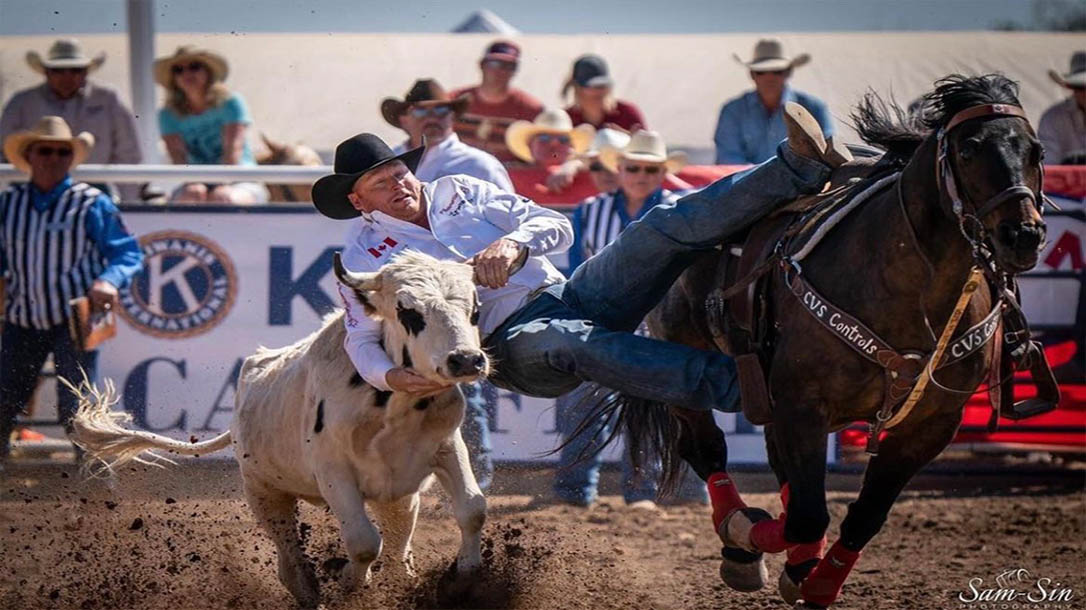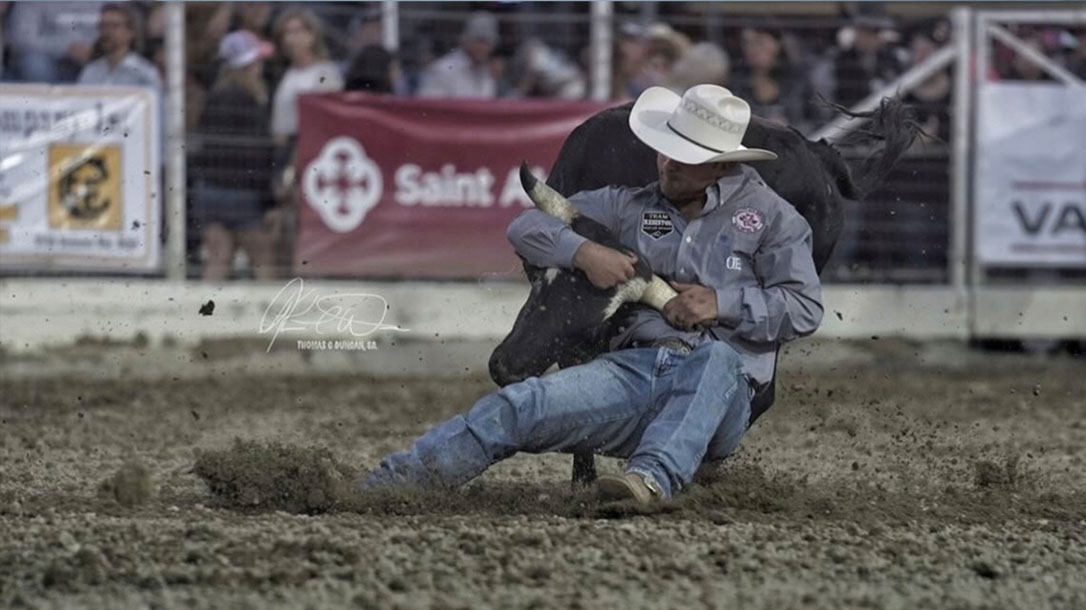With the increasing popularity of rodeos, more people are not only going to rodeos but also wanting to try their hand at different events. So what does it take to become a steer wrestler, aka bulldogger? I chatted with Curtis Cassidy (9x NFR qualifier & 12th time Canadian Champion), Tristan Martin (2x NFR qualifier and finished 5th in the world in 2021), and Tucker Allen (currently 30th in the world) to find out. Interview by Megan Nicole Larson

Steer Wrestling Requires Intense Training
Meg: What made you do steer wrestling vs. other rodeo events?
Tucker: I decided to steer wrestle because of the challenge and adrenaline that comes with the event. I always roped but grew up riding dirtbikes, so steer wrestling was that adrenaline rush I wanted.
Meg: With rodeo becoming more popular, many guys are getting into it without coming from a rodeo family or background. What’s a common misconception you see new guys have when they come to you to learn how to become a steer wrestler?
Curtis: I don’t know if it’s a misconception or just part of our sport, but the biggest problem most young steer wrestlers have is not being able to ride well enough. They can throw steers and do all the groundwork, but getting from the box to the steer can be an issue.
Meg: You brought up riding but let’s also talk about horses. How important is it to have a good horse?
Curtis: I think horsepower is the single most important asset to a steer wrestler. You can take an average steer wrestler and put them on a great horse, and it will take them to the next level! It also takes great steer wrestling from making the NFR to being world champions !!
Rodeo Has No Off-Seaon
Meg: How does your on-season trading compare to off-season training?
Tristan: Off-season is when I’m in the gym the most. I have a buddy who owns a gym in town and has helped me out a lot. Luckily I’m home more than I’m away because while I’m gone, it’s pretty difficult to work out. I try to eat right and stay active while I’m on the road, even if it’s not LIFTING. I keep resistance bands and set a bow flex of dumbbells in the trailer that I try to use on off days.
Tucker: Our training is pretty similar from off-season to in-season because we don’t really have an off-season. When I’m home, I practice as much as I can, 5 or 6 days a week ideally, also with weight training 3 to 4 days a week. When we are on the road, we go to the gym as much as possible and do a lot of lifts and explosive workouts. Our sport is like football, and being explosive but strong is important.
Curtis: My off-season is almost as crazy as my rodeo season. We go go go for three months guiding bighorn sheep hunters, moose, whitetail, and mule deer. September, October, and November. But amid all the craziness, we still find time to practice and ride young horses, as well as get prepared for the CFR.

Rest, Recovery And Steer Wrestling
Meg: How do you manage other aspects of your training, like getting enough sleep, recovery, & nutrition during the season? With all the traveling during the season, that has to be difficult.
Tristan: From the end of June to the beginning of August, our schedule is very busy in the heat of the summer run. You can be as strong as you want to physically when you leave for the summer, but this is when the mental aspect comes into play. We’re going to a rodeo almost every day, drive all night, and eat at a gas station twice a day if we’re lucky. At this point, I rely on muscle memory and get peace of mind from knowing how hard I worked and prepared in the off-season.
Meg: What are your go-to exercises in the gym? Are there certain lifts you think bulldoggers should be focusing on when training?
Tristan: The thing about bulldogging is that no muscle group is excluded, so I try to work out everything. The most important are the shoulders, core, and back. My go-to when I walk in the gym, of course, is bench press.
The Evolution Of Rodeo
Meg: Has your training changed at all over the years? If so, how?
Tucker: I changed some aspects of my practice this year by practicing like I’m at a rodeo. Treat every run like it’s for money and have a purpose when I practice. I never practice without a goal in mind for what I want to gain out of it.
Curtis: I don’t think my training has changed much over the years. We still do all the same training every practice session that we did back when I started. When we practice, we all have guys from beginner to NFR. So it’s basically all the same. I don’t run as many steers as I once did because of Father Time!
To learn more about these rodeo athletes and the upcoming workshops and clinics they offer, check out their Instagram accounts listed below.
Curtis Cassidy: curtiscassidy1
Tristan Martin: tristan_martin1
Tucker Allen: Tuck Allen





















